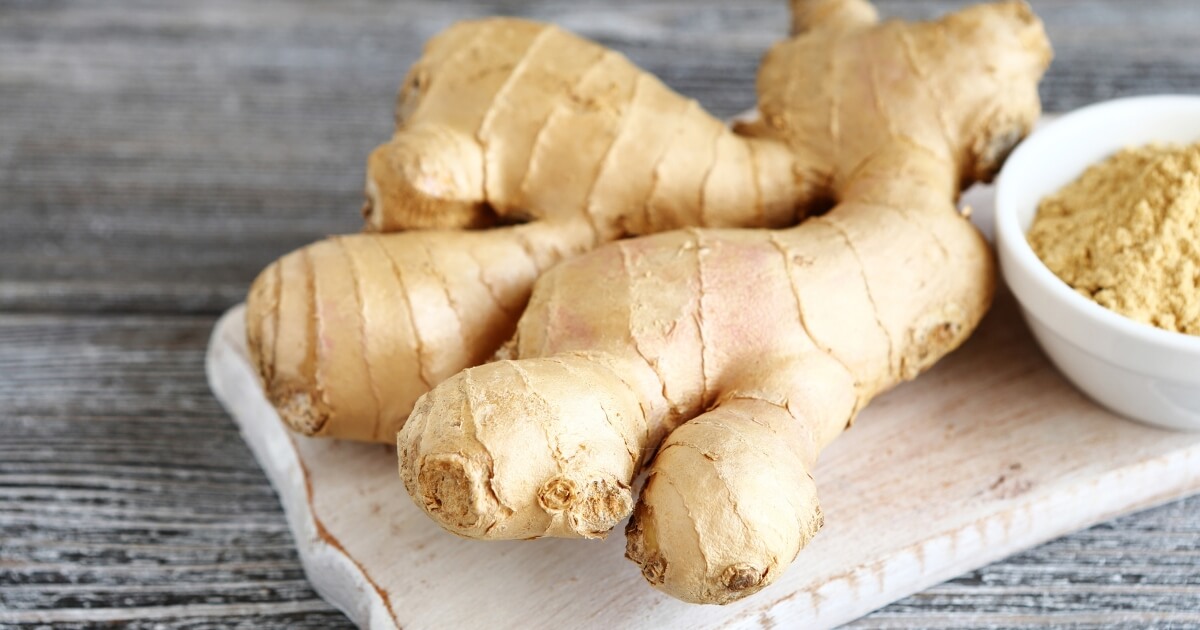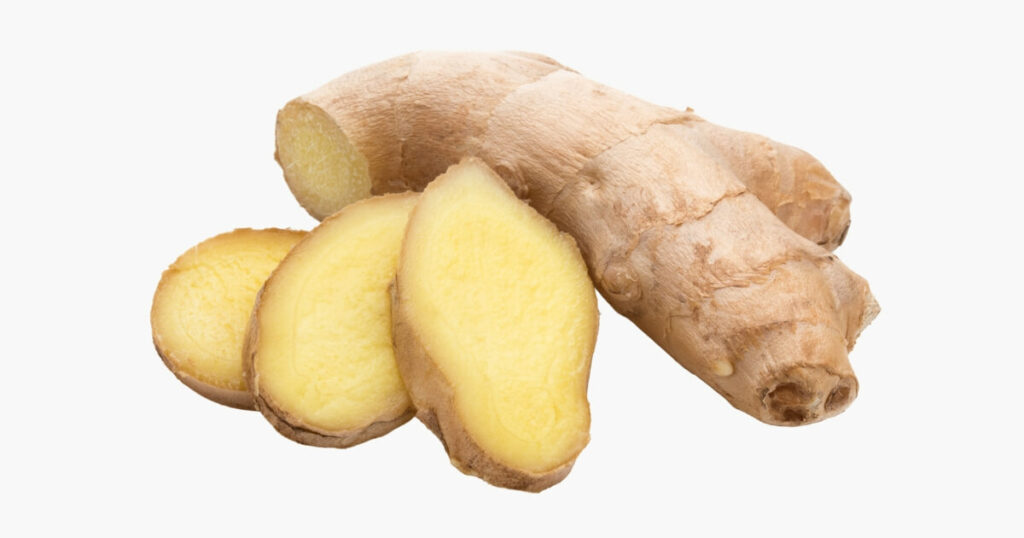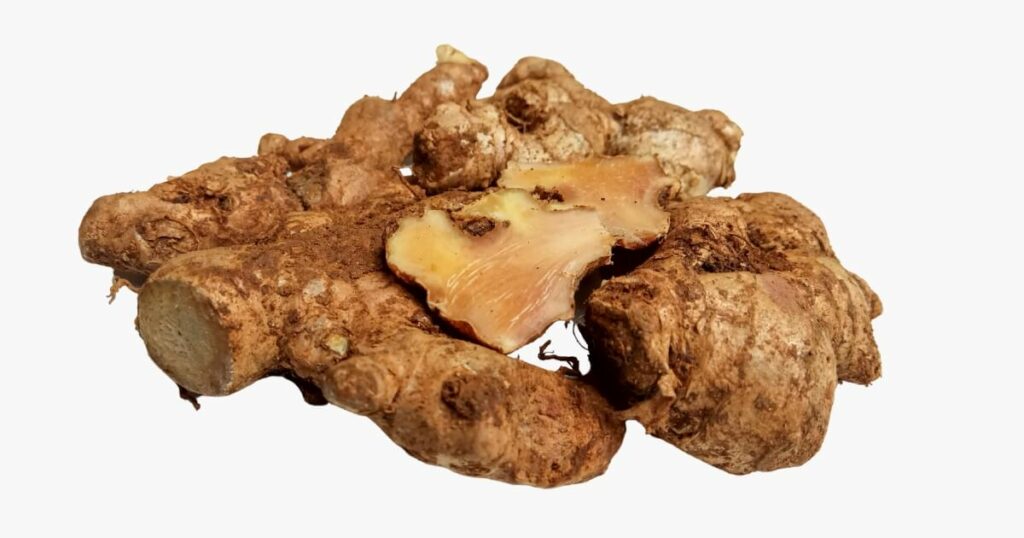Just like any other fresh produce, knowing when your ginger is past its prime is essential. Does ginger go bad? Yes, it does!
The most unmistakable sign that ginger has spoiled is the presence of mold. Fresh ginger should be firm, light-yellow tan, and emit a sharp, sweet, peppery scent. If you spot any mold or dark spots, or if your ginger gives off an unusual odor, it’s time to toss it out.

Moldy ginger can be a real letdown, especially when you’re in the middle of cooking. In this article, I’ll guide you through the signs of bad ginger in its whole form, ensuring you always use the freshest root in your dishes, and offer some tips on proper storage.
How To Know If Ginger Is Bad
The following comparison is a quick look at the differences between fresh ginger root and rotten ginger root.
What Does Fresh Ginger Look Like:

- Light tan, smooth skin without major blemishes or dark spots.
- Skin wraps snugly around the flesh, often with a slight shine indicating freshness.
- Feels firm when squeezed, showing it’s still moist and hasn’t dried out.
What Does Bad Ginger Look Like:

- Darkens in color, shifting from light tan to a brownish hue.
- The presence of mold can appear as fuzzy spots in white, green, or black.
- Becomes soft or spongy to the touch, indicating it’s starting to decay.
- Dark spots that are mushy and may start to smell indicate rotten ginger.
Before we look at the signs of spoilage in detail, you might also be interested in a guide I wrote about how long ginger root lasts, which helps you understand its shelf life once you bring it home from the grocery store.
Mold Growth

Signs of mold is a common sign that your ginger has gone bad. When you spot those fuzzy white, blue, green, or even black spots on your ginger, it’s time to say goodbye and toss it out.
Mold on ginger often develops due to prolonged exposure to moisture. If ginger is kept in a damp environment or if it’s not properly dried after being washed, it can become susceptible to mold growth.
Using moldy ginger in your dishes is a definite no-no. Not only can it impact the flavor and aroma of your food, but consuming mold can also have health implications.
I’ve always been cautious about this, especially after a friend shared a story about feeling unwell after unknowingly consuming moldy food. It’s a reminder that it’s always better to be safe than sorry and to regularly check your ingredients for any signs of spoilage.
Discoloration

Discoloration in ginger is a clear indication that it’s starting to spoil. However, discoloration might not always mean your ginger is unsafe to eat, but it’s a clear sign that it’s not at its best.
Fresh ginger typically has a vibrant, light yellow hue, but as it begins to deteriorate, it can darken, taking on a brownish appearance. This change in color is often due to oxidation, a natural process that occurs when ginger is exposed to air for extended periods.
I’ve noticed this, especially when I’ve left a piece of ginger out on the counter for too long, and it’s a reminder to always store it properly. However, frozen ginger may become discolored when frozen for a long period of time.
Another cause of discoloration in ginger is prolonged exposure to moisture. When ginger sits in a damp environment, it can become waterlogged, changing its color and texture. I’ve seen this happen when I’ve stored ginger in a plastic bag, or airtight container, when it wasn’t completely dry being doing so.
Discolored ginger in your dishes may not give the flavor you want. Not only does the flavor become muted, but the texture can also become less pleasant.
Soft or Mushy Texture
A fresh piece of ginger should always have a firm and crisp texture, making it easy to slice, dice, or grate into your dishes.
However, if you find that your ginger has become soft or mushy to the touch, it’s a clear indication that it’s starting to spoil.
This change in texture can be caused by various factors, including excessive moisture or simply the natural aging process of the ginger.
Again, one of the primary causes of a soft texture in ginger is excessive moisture. Moisture can accelerate the rotting process, turning your ginger soft and almost sponge-like.
Using ginger with a compromised texture becomes challenging to grate or slice, and the flavor can also become diluted.
I remember attempting to grate a soft piece of ginger for a marinade, and it just turned into a pulpy mess.
Over the years, I’ve found that one of the best ways to store whole, unpeeled pieces of ginger and maintain its firm texture is in a paper bag in the crisper. This method allows the ginger to breathe while staying cool, preserving its freshness for longer.
Unpleasant Odor
Fresh ginger emits a distinct, sharp scent, a delightful blend of peppery and sweet. However, if your ginger starts giving off an unusual or sour smell, it’s a warning sign that something’s amiss.
One of the causes of this unpleasant smell in ginger is bacterial growth.
When ginger is stored in unfavorable conditions, such as excessive moisture or warmth, it can become a breeding ground for bacteria.
These bacteria can produce gases and compounds that give off a sour or off smell.
Another reason for the change in smell can be mold growth. Mold can sometimes be present even if it’s not visible, and it can produce a musty odor.
It’s a reminder that even if the ginger looks okay, the smell can indicate underlying issues.
While an off-smelling piece of ginger might not always be harmful, it’s certainly not ideal for cooking. The flavor can be compromised, and the overall quality of your dish can suffer.
It’s always best to trust your senses and opt for a fresh piece when in doubt.
Loss of Spicy Flavor
One of the joys of using ginger in cooking is its bold, spicy kick. However, if you find that your ginger lacks that signature zing, it’s a sign that it’s past its prime.
A diminished flavor profile is a subtle indication of spoilage, which I’ve encountered more times than I’d like to admit.
I remember once brewing a pot of ginger tea, expecting that warm, spicy punch, only to be met with a bland, lackluster flavor.
The loss of flavor in ginger is the natural degradation of its essential oils over time. These oils are responsible for ginger’s robust taste, and as they break down, the flavor diminishes.
It’s kind of like using stale spices. They just don’t pack the same punch.
Another issue that can lead to a loss of flavor is improper storage. If ginger is exposed to air for extended periods, it can become dry and lose its potency.
While using flavor-depleted ginger might not pose any health concerns, it can certainly impact the quality of whatever you’re using it in.
I’ve tried to salvage bland ginger by using more of it in recipes, but the results were never quite the same, and it becomes very fibrous.
If there aren’t any other signs of spoilage, you might give it a quick taste before adding it to make sure that you’re getting the most out of this wonderful ingredient.
Wrinkled Skin
Ginger’s skin serves as a protective barrier, keeping its flavorful flesh fresh and juicy. But when that skin starts to wrinkle and lose its tautness, it’s a clear sign that the ginger is aging and losing its moisture.
The primary cause of wrinkled skin in ginger is dehydration. Just like how an apple or potato can shrivel up when left out, ginger can lose its moisture over time, leading to a wrinkled appearance.
I find this happens quicker during winter months when the air lacks humidity. But this also happens if your ginger is left uncovered or not stored properly.
While ginger with wrinkled skin might still be safe to consume, it might be best to toss it. After all, ginger is fairly cheap and readily available at most grocery stores.
Bad Ginger Signs FAQs
What happens if you eat bad ginger?
Eating spoiled ginger can lead to stomach upset and digestive discomfort. While ginger is known for its health benefits, including aiding digestion, consuming it when it’s gone bad can have the opposite effect.
If ginger has mold is it bad?
Yes, if your ginger has mold, it is bad. It’s best to discard the whole thing. Mold can produce mycotoxins, which can be detrimental to health when ingested. I once found a piece of ginger with a tiny mold spot and thought about cutting it off and using the rest. However, I decided against it, remembering that mold has roots that penetrate deeper into the food, making it unsafe.
Why is my ginger gray inside?
Ginger turning gray inside can be due to “blue ring” caused by factors like storage conditions or age. This gray hue is natural and doesn’t always indicate spoilage, but the flavor might be milder than golden ginger.











